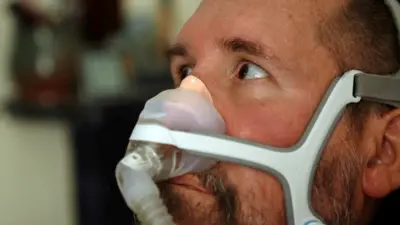We've updated our Privacy and Cookies Policy
We've made some important changes to our Privacy and Cookies Policy and we want you to know what this means for you and your data.
Alzheimer's brain plaques 'rapidly cleared' in mice
- Author, James Gallagher
- Role, Health and science reporter, │╔╚╦┐ņ╩ų News
Top Stories
Destructive plaques found in the brains of Alzheimer's patients have been rapidly cleared by researchers testing a cancer drug on mice.
The US study, , reported the plaques were broken down at "unprecedented" speed.
Tests also showed an improvement in some brain function.
Specialists said the results were promising, but warned that successful drugs in mice often failed to work in people.
The exact cause of Alzheimer's remains unknown, but one of the leading theories involves the formation of clumps of a protein called beta-amyloid. These damage and kill brain cells, eventually resulting in memory problems and the inability to think clearly.
Clearing protein plaques is a major focus of Alzheimer's research and drugs are already being tested in human clinical trials.
In the body, the role of removing beta-amyloid falls to apolipoprotein E - or ApoE. However, people have different versions of the protein. Having the ApoE4 genetic variant is one of the biggest risk factors for developing the disease.
Top Stories
Helping hand
Scientists at the Case Western Reserve University in Ohio were investigating ways of boosting levels of ApoE, which in theory should reduce levels of beta-amyloid.
They tested bexarotene, which has been approved for use to treat cancers in the skin, on mice with an illness similar to Alzheimer's.
After one dose in young mice, the levels of beta-amyloid in the brain were "rapidly lowered" within six hours and a 25% reduction was sustained for 70 hours.
In older mice with established amyloid plaques, seven days of treatment halved the number of plaques in the brain.
The study said there were improvements in brain function after treatment, in nest building, maze performance and remembering electrical shocks.
Researchers Paige Cramer said: "This is an unprecedented finding. Previously, the best existing treatment for Alzheimer's disease in mice required several months to reduce plaque in the brain."
Top Stories
In people?
The research is at a very early stage, and drugs often do not make the leap from animal experiment to human treatment.
Fellow researcher Prof Gary Landreth said the study was "particularly exciting and rewarding" and held the "potential promise of a therapy for Alzheimer's disease".
However, he stressed that the drug had been tested in only three "mouse models" which simulate the early stages of the disease and are not Alzheimer's.
He warned people not to "try this at home", as the drug had not been proven to work in Alzheimer's patients and there was no indication of what any dose should be.
"We need to be clear, the drug works quite well in mouse models of the disease. Our next objective is to ascertain if it acts similarly in humans," he said.
His group is preparing to start trials in a small group of people to see if there is a similar effect in humans.
The disease is likely to become more common as people live longer. The Alzheimer's Society predicts the number of people with dementia will reach a million by 2021 in the UK alone.
Its research manager, Dr Anne Corbett, said: "This exciting study could be the beginning of a journey towards a potential new way to treat Alzheimer's disease.
"However, this is very early days. People with Alzheimer's should not rush to get this drug, as we need much more research to establish if it has benefits for humans."
Dr Simon Ridley, head of research at Alzheimer's Research UK, said the findings were "promising" but any effect was still unproven in people.
"There are a number of drugs in development that aim to clear amyloid from the brain, and the jury is still out on whether this approach will be successful as a treatment for Alzheimer's."
David Allsop, professor of neuroscience at Lancaster University, said: "I would say that the results should be treated with cautious optimism.
"It looks promising in the mouse model but in recent years, these types of experiments in mice have not translated well into humans."
Top Stories
More to explore
Most read
Content is not available








